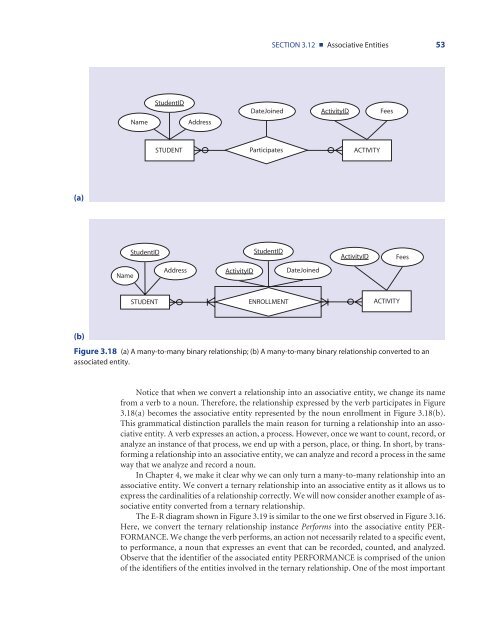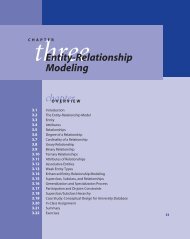Web-DSS-Chapter-03
Web-DSS-Chapter-03
Web-DSS-Chapter-03
Create successful ePaper yourself
Turn your PDF publications into a flip-book with our unique Google optimized e-Paper software.
SECTION 3.12 ■ Associative Entities 53<br />
Name<br />
StudentID<br />
Address<br />
DateJoined<br />
ActivityID<br />
Fees<br />
STUDENT<br />
Participates<br />
ACTIVITY<br />
(a)<br />
StudentID<br />
StudentID<br />
ActivityID<br />
Fees<br />
Name<br />
Address<br />
ActivityID<br />
DateJoined<br />
STUDENT<br />
ENROLLMENT<br />
ACTIVITY<br />
(b)<br />
Figure 3.18 (a) A many-to-many binary relationship; (b) A many-to-many binary relationship converted to an<br />
associated entity.<br />
Notice that when we convert a relationship into an associative entity, we change its name<br />
from a verb to a noun. Therefore, the relationship expressed by the verb participates in Figure<br />
3.18(a) becomes the associative entity represented by the noun enrollment in Figure 3.18(b).<br />
This grammatical distinction parallels the main reason for turning a relationship into an associative<br />
entity. A verb expresses an action, a process. However, once we want to count, record, or<br />
analyze an instance of that process, we end up with a person, place, or thing. In short, by transforming<br />
a relationship into an associative entity, we can analyze and record a process in the same<br />
way that we analyze and record a noun.<br />
In <strong>Chapter</strong> 4, we make it clear why we can only turn a many-to-many relationship into an<br />
associative entity. We convert a ternary relationship into an associative entity as it allows us to<br />
express the cardinalities of a relationship correctly. We will now consider another example of associative<br />
entity converted from a ternary relationship.<br />
The E-R diagram shown in Figure 3.19 is similar to the one we first observed in Figure 3.16.<br />
Here, we convert the ternary relationship instance Performs into the associative entity PER-<br />
FORMANCE. We change the verb performs, an action not necessarily related to a specific event,<br />
to performance, a noun that expresses an event that can be recorded, counted, and analyzed.<br />
Observe that the identifier of the associated entity PERFORMANCE is comprised of the union<br />
of the identifiers of the entities involved in the ternary relationship. One of the most important



